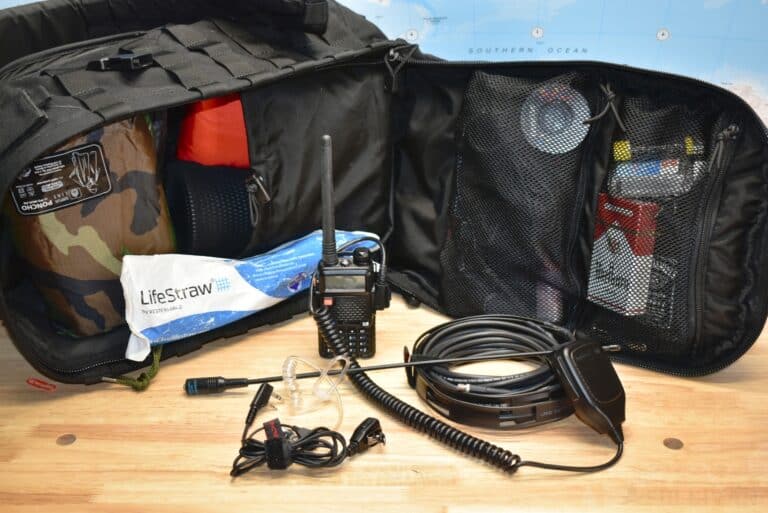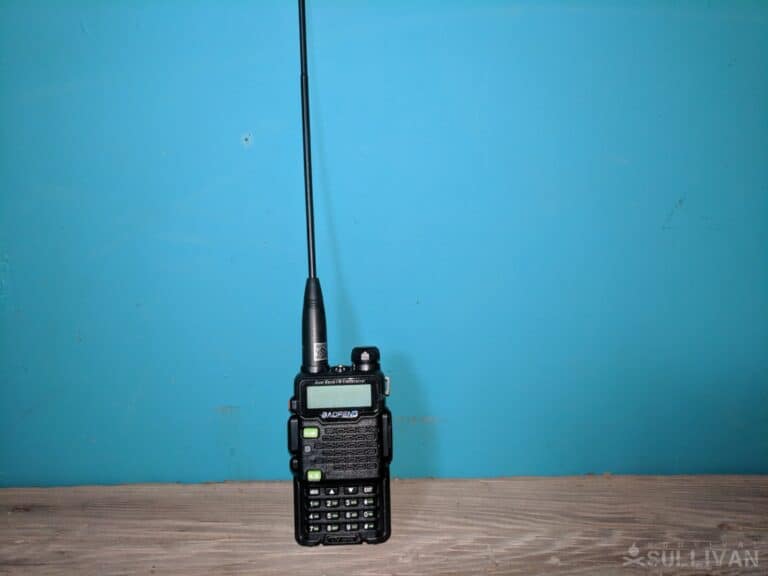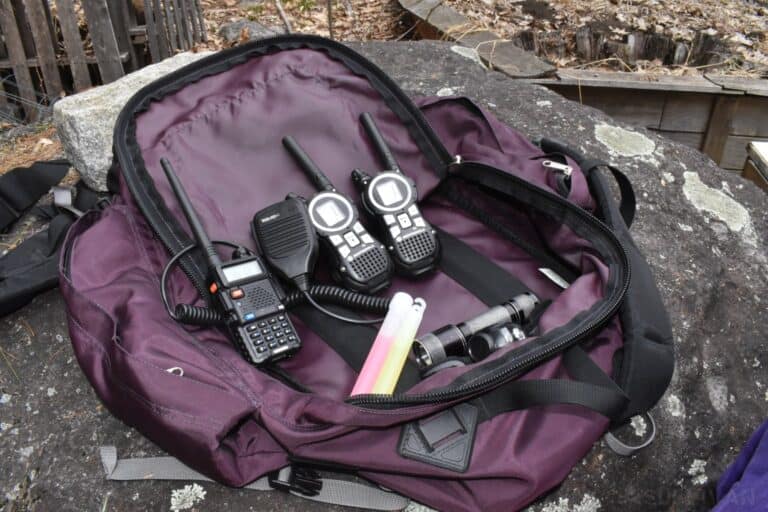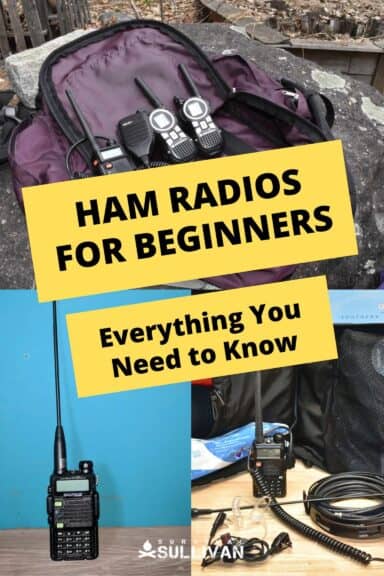Once you’ve got the survival basics covered, things like food, water and shelter, in any kind of major disaster situation it’s time to start thinking about communications. Ham radio has been around a very long time, and even in the era of cellular communications it isn’t going anywhere and remains reliable.

When everything else fails, you’ll still be able to rely on radio with the right setup. But it can be pretty intimidating if you didn’t grow up doing it. Luckily, it’s easier to get started than you might think, especially when you have this handy guide to help you.
Grab your headset, power up, and we’ll get right to it…
Just What is Ham Radio?
Ham radio is just a colloquial term, though an official one at this point, for amateur radio. Basically, it consists of and refers to civilian amateur radio operators, the radio equipment itself, and the bands and frequencies set aside specifically for amateur use.
So whenever you hear ham radio brought up in the context of radio communications, you’ll have a broader understanding of what’s being discussed.
What Does the ‘Ham’ Stand For?
It doesn’t stand for anything, though it is a common assertion you’ll see on the internet.
I won’t get into all that here, though I discussed it in depth before here, but all you need to know is that ham is shorthand referring to “amateur,” specifically, and everything that that it entails in the context of radios and radio operations.
Why Get into Ham Radio in the First Place?
There are tons of great reasons to get into ham radio, not the least of which is it it’s just a great and fulfilling hobby, and you’ll be doing your part to help preserve a critical, legacy skill set with many real-world applications.
But, of course, we are preppers, and if you’re reading this article, you are here for a purpose and that purpose is to be more useful and resilient in times of trouble.
Maintaining communications, be it with friends, relatives, members of your group, or even first responders is critical in a crisis. At least it is if you want to verify status, coordinate efforts, and basically get through a situation in one piece without “what if’ing” yourself half to death!
And I’ve got great news in that regard: learning to operate a ham radio and do so fluently is one of the very best things that you can do to be more prepared! Consider what ham radio can do for your overall readiness:
Redundant, Self Contained Emergency Comms
The great thing about ham radio communication is that it is extremely resilient compared to cell phones, the internet, and other forms of modern, electrically powered data exchange.
If you have a ham radio and it’s powered, and someone else that is in-range has a set, it is possible for you two to communicate.
You might have a handheld, they might have a base station, and someone else might have a mobile radio. You don’t need to rely on any complicated, fragile cell network as an intermediary.
Long Range Communications
Speaking of long-range communications, it’s possible to talk to people that arefar away from you using nothing but a ham radio. And I mean really far away!
Across the state, across the country, across the world, or maybe even off the planet! No kidding: ham radio operators can even talk to astronauts on the International Space Station when conditions are right!
Now, you might not think that is a big deal considering the state of modern internet-based communications, but again, only through ham radio is it possible to do so with the minimum amount of intermediaries and dependency on increasingly fragile technology…
Direction Finding
Ham radio, and some other relevant skill sets in conjunction, can be used for direction finding, or radio orienteering.
This is useful for locating signals that are broadcast by base stations, other radio operators that might be lost or in trouble, or even locating potentially hostile or adversarial transmissions for intelligence gathering purposes.
In your situation, and with your objectives, this may be useful for you or it might not, but it’s an undeniable capability that can come in handy.
Networking
Ham radio operation is a great way to network, and in more ways than one…
For starters, using radio-to-internet and internet-to-radio interfaces, or even just some specialized ham radio rigs, you can send data in the form of images, text, and more, or use your radio as a type of control for different systems.
That’s an entire series of articles unto itself, but something to keep in mind for now if you’re just getting started.
More than this, meeting and getting to know other ham radio operators in your area is a great way to increase involvement with like-minded people in and around your town and region, maybe even elsewhere in the world!
You can also come to be seen as a vital asset or partner to first responders dealing with a crisis, and who knows what that relationship will lead to!
If you weren’t sold before, I’m willing to bet that you are now. So, time to get down to brass tacks so you can get on the air.

Before You Buy: You Must Get Licensed
Before you do anything else, and I hope this doesn’t curb your enthusiasm, you’ve got to get licensed.
I know, I know. But that’s just the way it is. If you want to operate anything more than a cell phone or those cheap, dinky walkie-talkies that are scarcely better than a kid’s toy, you’ve got to get the license so you can legally get on the air.
This isn’t a joke, either: the FCC covers and regulates all hand radio operations, and running afoul of them means you could be fined or even criminally charged. Sometimes those fines, and the charges, can be life-altering!
Now, don’t worry about that, as you have to be actually going out of your way to get into that kind of trouble, but you still don’t want to get off on the wrong foot.
There are three grades of license that you need to know about, each of them giving you legal access to more frequencies and more powerful radios that will allow you to broadcast further or do more with your set.
Presented in ascending order of difficulty and privileges.
Technician: this is the first and easiest ham radio license to get. It’s really easy, and Boy Scouts and kids qualify for and pass it all the time, so it’s just a little bit of study you’ll be able to get it with no problem.
Consists of a written examination, and once obtained allows you legal access to VHF, or Very High Frequencies and UHF, or Ultra High Frequencies.
General: the General license is one step up in difficulty and complexity from the Technician license, and consists of a 35-question written examination on some more advanced radio theory. You must already hold a Technician class license to test for your General license.
You’ll have to work and study a little bit harder to pass this one, but it’s still totally achievable even for a motivated beginner.
In addition to VHF and UHF, you’ll get legal access to HF, or High Frequencies, which will let you transmit a lot farther. This is a great benchmark for a motivated prepper getting into ham radio.
Extra: the Extra license is, as you’d expect, the highest, best, most privileged and also most difficult to obtain for ham ops.
The biggest difference between it and the General class licenses that you must pass a pretty tough 50-question test covering regulations, best practices, radio design and operation, and more. You must really prove you know your stuff concerning radio theory!
You’ll get access to all of the previous frequencies, along with a few specially reserved ones to be accessed only by Extra-class license holders.
Do I Need To Know Morse Code in Order To Pass?
No, although may articles online will tell you otherwise. The Morse Code has been scrapped for some time now in the USA.
Which Grade of License Should I Get?
If you want access to ham radio only for reception and transmissions in and around your hometown, or possibly the nearby region, the Technician license is just fine.
However, you can do a whole lot more and transmit a whole lot farther if you have the General license, and it is only a very small bump in difficulty to pass that test.
And, of course, your license can be upgraded, so there’s no reason why you shouldn’t go ahead and aim for your Technician class license so you can get started legally and learn as you go, and with your continued practice and a little bit more study you’ll easily be able to qualify for General.
If you love ham radio after you’ve been doing it a while, and you want to flex your muscles a bit, then you could go for the Extra-class license, but in my experience, you really don’t have to do that for preparedness purposes.
Prepping for the Test
There are lots of online guides as well as good old-fashioned dead tree books and more that will help you study for and pass the different license tests. The ARRL, for Amateur Radio Relay League, is one of your best resources for studying and also for getting involved in the broader ham community.
They even have the official question pool for the Technician grade test online. Make that your first stop and then consider getting a study guide if you think you need a little more help. Once you are ready, the test can be taken in printed form or online.

What Kind of Radio Equipment Do You Need?
Talk to any ham enthusiast and you’ll quickly learn that checking out each other’s rigs is part of the fun.
Some people want powerful base stations that offer maximum capability, whereas other folks want a mobile or even handheld radio that allows them to get on the air even when they are on the go.
This is certainly an interesting part of the hobby or skill set, but for your purposes you need to design your rig so that it fits into your overall preparedness plan:
- Do you want your rig to stay at home in a “ham shack” or in another location?
- Do you want it to be in your vehicle?
- Does it need to fit in a bug-out bag?
But, regardless of the form factor, a ham radio rig always consists of the following basic components…
Receiver or transceiver: This is the part that receives signals, the receiver, or sends and receives signals, the transceiver. , obviously, is a combination of a transmitter and receiver.
This determines the overall form factor of your ham radio setup, with smaller but less powerful units being portable, while larger and more powerful units, capable of transmitting further, tend to be mounted on desks or racks at home or else carried aboard larger vehicles where space is not at a premium.
Antenna: the most visible and probably most iconic part of any radio.
The shape, type, and height of the antenna greatly impact how effectively you can receive signals but also how effectively you can send them. Antennas are broadly categorized into directional or unidirectional types for different purposes.
Power supply: the one thing you’ve got to have if you want to make your radio work is electricity. No exceptions!
Most units are powered from AC power using a converter that changes common household electricity to the direct current needed for radio functionality. Electricity can be supplied by the power grid, a generator, or anything else capable of creating it.
Portable and handheld rigs often use battery packs, solar panels, or other alternatives to keep the power flowing while on the go- no power grid required!
Microphone. If you’re going to send your voice over there, you’ve got to have a mic. It can be a fixed mic on a stand or boom, or integrated into a headset.
Headphones or speakers. Allows you to hear incoming signals on the frequency you’ve tuned into.
Tuner. You’ll need a tuner to match your transmitter or transceiver’s output impedance to the antenna’s impedance, maximizing efficiency. Note that a tuner might be a built-in component of your transceiver or a standalone component that can be integrated into a separate set.
SWRM: Stands for Standing Wave Ratio Meter. This tool measures the performance and overall efficiency of your antenna in radiating the power of your radio set.
Needed to help you properly install, place, and optimize your antenna for maximum effectiveness and also the prevention of damage in case of more powerful sets.
Cables, Connectors and Misc.: If you saw a nice, tidy ham shack setup before, you probably didn’t see too many cables running all over the place.
But one that is experimental, ad hoc, or not installed in a nice rack or holder probably looks like a rat’s nest of different cables and connectors!
They’re always necessary, and the exact kind and number you need is dependent on your specific combination of equipment.
Don’t cheap out because high-quality cables and connectors are vital for good reception and transmission, and if you need to run a cable that is quite long, you might need a specialized type.
Your ham radio equipment dealer or mentor can help you figure out exactly what you need.
How Much Should I Expect to Spend on a Ham Radio?
It’s easy to feel overwhelmed if you just do a search for radio equipment. You’ll probably be confronted with some major sticker shock!
Take a breath: I promise it is not as bad as you’re thinking…
The good news is that you can get into a legitimate, real-deal ham radio operation with, a basic, cheap handheld, for under $50.
Yeah, if you want a more advanced system with higher-end components and correspondingly better range and performance, you should expect to spend anywhere between $700 and $3,000 for a good vehicle-mounted radio, or one you can set up in your home.
Like so many other things, where there’s a will there’s a way, and no matter what your budget is I promise you can get on the air with ham radio in a meaningful way, it will help you and others in a time of need.
Do I Need a Dual-Band or Tri-Band Radio?
This is a common point of confusion for aspiring ham operators. Simply, dual-band and tri-band refer to what groups of frequencies the radio can utilize.
A dual-band radio will cover everything that you can access on your technician and general license, VHF and UHF. A tri-band radio gives you access to UHF as well, needed if you’ve got your extra license.
In short, unless you know you’re going for that extra license, you just need a dual-band.
What are Repeaters?
When you first start dipping your toe into ham radio, particularly if you are interacting with a local group of enthusiasts, you’re going to start hearing talk of repeaters and tuning into them. What does that mean? What is a repeater?
A repeater is exactly what its name suggests: a device or station that repeats your signal. However, a repeater, or at least a good one, will repeat it with considerably more power than what your radio can provide on its own.
This allows you to reach out even further than you would be able to on your own, or just get your signal over obstacles like mountain ranges which might block it.
To interact with a repeater, you, as the transmitter, need to set your radio to repeater mode and then send on a frequency that will be picked up by the repeater which will then transmit it out on a different frequency that listeners will tune to.
Likewise, to hear what they say back, you should tune into the frequency of the repeater also.
And if you’ve been paying attention, if it sounds like you’re using two different frequencies to get the job done, you are correct: repeaters use dual-band systems as detailed above!
What You Absolutely Cannot Do with Your Ham Radio
As a beginner, a big part of your job, such as it is, will be avoiding mistakes, infractions and general radio faux pas.
Without question, you must absolutely avoid getting in trouble with the FCC! If you want to stay on the straight and narrow never, ever do the following on your radio, even as a joke. All of them are illegal! And, mind you, these will be on your test… so pay attention!
Music: play music of any kind for any duration, and for any reason on a ham radio frequency is absolutely illegal.
Interference / Denial of Operations: interfering with any radio frequency, ham or otherwise, by jamming, flooding the frequency or any other sort of chicanery is totally illegal, as is damaging or disrupting repeaters or other radio sets for any reason.
Commercial Purposes: yep, you read that right. You cannot use your ham radio for any commercial purpose of any kind whatsoever. Basically, you can’t make money with it. This includes advertising or paid relay services. That falls under different FCC guidelines and all of the attendant taxation, of course!
Coordinating Any Illegal Activity: it seems obvious, but it bears repeating. You cannot use your ham radio in any way to aid, facilitate, or coordinate illegal activity of any kind. No exceptions!
Broadcast Without a License or Outside of Your License Permissions: the FCC takes that licensing requirement seriously, and you better do the same. You must be properly licensed to broadcast, or to allow someone to broadcast under your direct supervision.
Fail to Identify Yourself: identifying yourself when transmitting, or periodically when listening, using your radio call sign is mandatory.
Consider Joining Ham Clubs in Your Area for Advice and Growth
After reading, learning and understanding of this you are well on your way as a beginning ham radio operator. However, you no doubt know that there is so, so much more to learn!
To help you do this, and help you get even more involved with radio operations, it pays to join a local or national club that can help you.
The ARRL is a great place to start, and also a great way to get involved at the state and National levels in case of emergency.
Amateur Radio Emergency Service, or ARES, is a professionally regulated group that gets civilian radio operators involved in legitimate emergency management situations, and members form an important link in overall civil readiness.
Be sure to look into both of those, and also run a search on various social media sites for groups that might be in your city or you’re part of the state. I promise, you’ll be surprised to learn how welcoming and excited veteran ham operators are to bring you, as a beginner, into the fold.


Tom Marlowe practically grew up with a gun in his hand, and has held all kinds of jobs in the gun industry: range safety, sales, instruction and consulting, Tom has the experience to help civilian shooters figure out what will work best for them.
